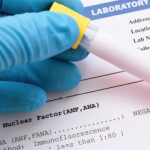Abstract 0246—Extreme Fatigue in Patients with Systemic Lupus Erythematosus and Neuropsychiatric Symptoms
Dr. Pisetsky: Fatigue is one of the most common and disabling symptoms of SLE, although it is not part of the classification criteria nor most indices for disease activity. This study investigated the possible association of fatigue with neuropsychiatric manifestations of SLE (NPSLE). Attribution is always an issue with NPSLE, but the study failed to find differences in the frequency of fatigue irrespective of the presence of NPSLE manifestations. Overall, approximately 75% of patients were fatigued, with about 50% extremely fatigued. In view of the impact of fatigue on quality of life, elucidating the origin of this symptom and developing effective therapies are important priorities. It may also be worthwhile to include fatigue as an outcome measure in clinical trials of new agents and, thereby, help develop patient-centered treatment approaches.
Abstract 0251—Dynamics of Anti-Nuclear Antibodies in a Longitudinal Study of a Large Systemic Lupus Erythematosus Cohort
Dr. Pisetsky: In the new ACR/EULAR criteria for the classification of SLE, a positive ANA test is required for classification, with clinical manifestations receiving points to reach a numerical threshold for classification. Although this approach necessitates positive serology for classification, a number of studies have recently suggested that patients with SLE may lack a positive ANA, either because of assay issues or the effects of treatment or natural history of disease on the magnitude of ANA responses. Using a large number of patients from the SLICC [the Systemic Lupus International Collaborating Clinics] cohort, this study showed that about 85% of patients were ANA positive by an IFA (immunofluorescence assay) or an ELISA at each time point assessed over the first five years. Those patients who had a least one negative ANA test had features of milder disease in terms of disease activity or use of steroids and immunosuppressive agents. This study supports recent data about variability of ANA status even in early disease and points to a role of ANAs in mediating disease manifestations.
Abstract 0848—Delineation of a Proinflammatory Cytokine Profile Targeted by Janus Kinase 1/2 Inhibition Using Baricitinib in a Phase 2 Systemic Lupus Erythematosus Trial
Dr. Pisetsky: Baricitinib is a novel, targeted synthetic DMARD (tsDMARD) which can inhibit Janus kinase (JAK) 1 and JAK2 signaling and therefore impact simultaneously on a number of cytokines. As such, this agent differs from therapies directed at a single cytokine by monoclonal antibodies or soluble receptors. This study characterized levels of cytokines in patients with SLE from a Phase 2 study of 4 mg of baricitinib compared with a control group. The results indicated a significant decrease in levels of serum IL-12/23p40 and IL-6 at week 12, which was maintained through week 24. In contrast, levels of IFN-α and IFN-γ were not affected. Future studies with baricitinib and other novel agents will help define the role of different cytokines in the pathogenesis of SLE and the utility of cytokine assays as biomarkers for assessing therapeutic efficacy.

